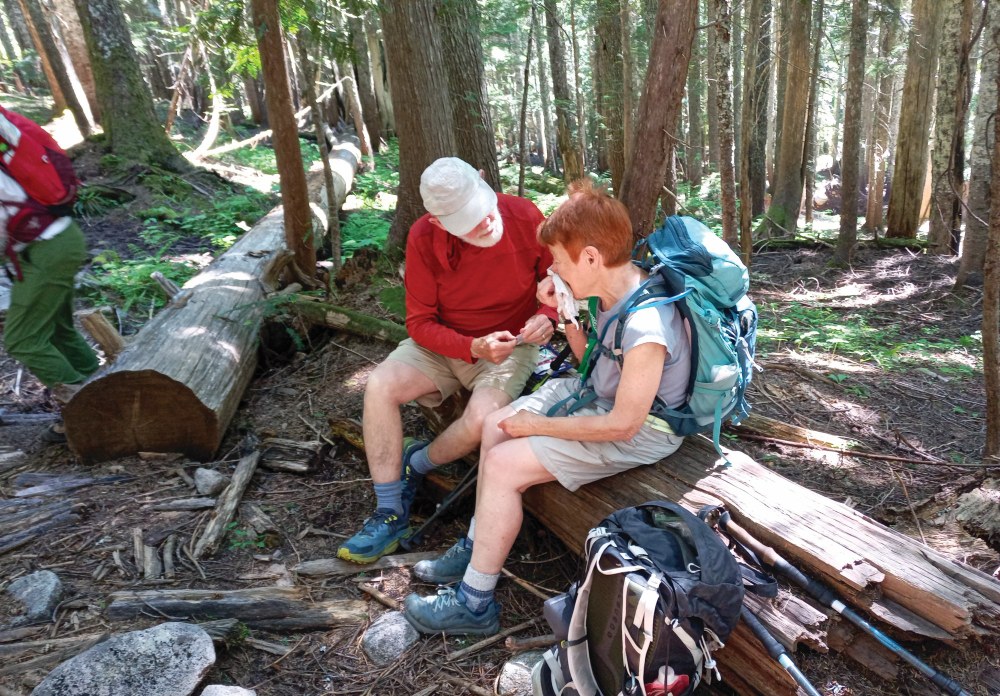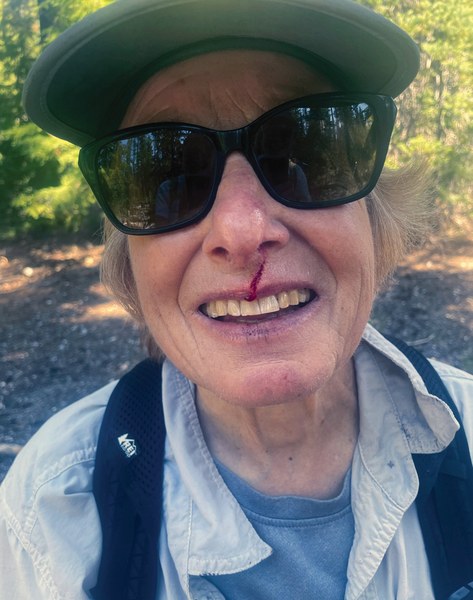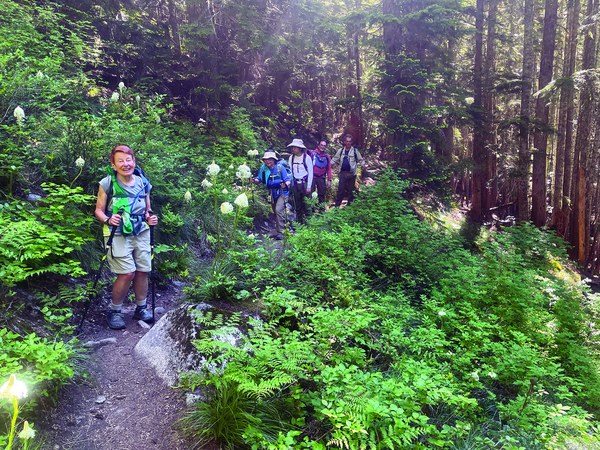
In the summer of 2023, hikes, urban walks, and family celebrations had me digging out the first aid kit nearly weekly. My wife Nancy and I keep our Wilderness First Aid badges current, and the seven kids and eleven grandkids provide abundant practice around our Redmond farm with stinging nettle, bites, stings, sprains, breaks, bruises, gashes, cuts, and the occasional bump on the head.
I can thank my 30 years of off-and-on Boy Scout leader experience for my first aid familiarity, as well as extensive experience leading outdoor trips for public schools, volunteering with The Mountaineers, and refereeing soccer games with their various medical emergencies. I even worked as a surgical orderly and ER tech in a small California hospital, and currently research traumatic brain injuries with neurosurgeons and trauma doctors in the U.S. and Latin America. So why was I fumbling to dig out my first aid kit atop Little Si last year when Nancy drew blood on her leg and arm?
Two weeks earlier, I had dived into the generously sized first aid box in the pantry that contained 40+ years of accumulated bandages, splints, and pins. My kit was newly refreshed. But when Nancy stumbled and fell, two nearby women found her and dressed her wounds before I could finish digging out my kit. 40+ years of first aid supplies were unhelpful crammed at the bottom of my bag.
Thinking beyond supplies
My wife and I hike and urban walk frequently – three to five times a week – and occasionally backpack. We maintain a small farm with cattle, chickens, fruit trees, berries, and vegetables. And we’re both on the other side of 75, so our balance, speed, and strength are past their prime. All this to say, there is generous opportunity for outdoor injury.
 Nancy's injured lip after a fall taken while hiking in Oregon. Photo by Peter Hendrickson.
Nancy's injured lip after a fall taken while hiking in Oregon. Photo by Peter Hendrickson.
Nancy has a life-long “visual field cut,” meaning her peripheral vision is nil in all directions. After a few years of very few slips, trips, and falls, her tumbles frequency spiked last summer. It seemed like every week there was a curb, stone, depression, limb, or lip that caused a fall. While the contents of a first aid kit are quintessential, Nancy’s Little Si wound made me think beyond “What should I carry for first aid?” to “Where should I carry it?”
Over the past 45 years, Mountaineers Wilderness First Aid courses have provided course supplies for instructional, one-time use. Although guidance is offered on first aid kit contents, we rarely practice how to access first aid kits with our own backpack or daypack. Many helpful resources exist on how to create a first aid kit, but instructions frequently lack information on accessibility.
Post Little Si, I learned the value of packing first aid supplies in areas I can quickly reach. I carry three kits: two for immediate retrieval to stop the bleed or calm the itch, and another dry bag tucked away with The Ten Essentials. Before going out, I think about what I need “right now,” like when I’m returning from the pasture with a bloody arm (skin is thinner in your 80s) or tending to Nancy after a scrape.
My pack’s top pocket carries a double sandwich bag of alcohol wipes, assorted Band-Aids, Tegaderm Film, nine non-stick 3x4 pads, and two non-stick 2x3 pads.
The inside pocket has other essentials sealed inside a waterproof pouch (I prefer Adventure Medical Kit’s .9 bag): a 10ml syringe (to rinse the injury); 1oz triple antibiotic ointment; two bags of Benzoin tincture swabsticks; six or more alcohol swabs; a medical bag of single tablets such as ibuprofen, aspirin, acetaminophen, diphenhydramine, and Sting Relief; a Steri-Strip suture; 5cmx3.75m roller gauze; and a rescue inhaler (I have asthma).
Note that my urgent meds are in the top, zipped pockets of my pack. Nancy keeps her epi-pen handy at the top of her pack. We both inform fellow hikers where our urgent aids are stowed. The non-urgent kit with my Ten Essentials is in the dry bag packed away.
 Nancy leading a CHS trip to Island and Rainbow Lakes, July 2024. Photo by Peter Hendrickson.
Nancy leading a CHS trip to Island and Rainbow Lakes, July 2024. Photo by Peter Hendrickson.
“Learning by a thousand small cuts”
This July, Nancy and I were returning from leading a Conditioning Hiking Series trip to Island and Rainbow Lakes when, even with poles deployed, Nancy tripped on a small rock, landing on her right arm, leg, and face. I was the co-leader and first aid officer, so I provided immediate assistance. All injuries appeared minor, but the small scratches on her nose and cheek required attention. This time, alcohol wipes came easily to hand from my pack’s top pocket. A fellow hiker offered his new, mirrored compass to provide Nancy a look at her minor damage. No Band-Aids required. This is “learning by a thousand small cuts.”
Keeping first aid supplies accessible doesn’t just apply to backcountry adventures, but frontcountry and at-home mishaps as well. Accidents can happen anywhere. At the farm, Nancy keeps her skills primed by dressing my frequent cuts and scrapes. A box of alcohol wipes sits left of the sink on the bathroom counter beside a box of Band-Aids. Backpack pocket or bathroom sink, always keep first aid materials stocked and accessible.
This article originally appeared in our fall 2024 issue of Mountaineer magazine. To view the original article in magazine form and read more stories from our publication, visit our magazine archive.
Add a comment
Log in to add comments.Nicely written Peter! You've provided lots of useful information and it's prompted me to add a small first aid kit to the top pocket of my pack.
Thanks Peter! Coincidentally, Foothills First Aid just posted a clinic on "First-Aid Kit Essentials for Frontcountry and Backcountry" for Jan 6th. Start the New Year with a new (or updated) kit!
 Peter Hendrickson
Peter Hendrickson